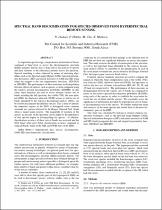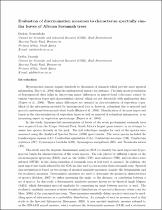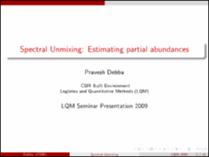 ResearchSpace
ResearchSpace
Spectral band discrimination for species observed from hyperspectral remote sensing
JavaScript is disabled for your browser. Some features of this site may not work without it.
- ResearchSpace
- →
- Research Publications/Outputs
- →
- Conference Publications
- →
- View Item
| dc.contributor.author |
Dudeni, N

|
|
| dc.contributor.author |
Debba, Pravesh

|
|
| dc.contributor.author |
Cho, Moses A

|
|
| dc.contributor.author |
Mathieu, Renaud SA

|
|
| dc.date.accessioned | 2009-09-28T10:32:09Z | |
| dc.date.available | 2009-09-28T10:32:09Z | |
| dc.date.issued | 2009-08 | |
| dc.identifier.citation | Dudeni, N., Debba, P., Cho, M.A. and Mathieu, R. 2009. Spectral band discrimination for species observed from hyperspectral remote sensing. Evolution in remote sensing. IEEE GRSS First Workshop on Hyperspectral Image and Signal, Grenoble, France, 26-28 August 2009. pp 1-4 | en |
| dc.identifier.isbn | 978-1-4244-4948-4 | |
| dc.identifier.uri | http://hdl.handle.net/10204/3619 | |
| dc.description | Evolution in remote sensing. IEEE GRSS First Workshop on Hyperspectral Image and Signal, Grenoble, France, 26-28 August, 2009 | en |
| dc.description.abstract | In vegetation spectroscopy, compositional information of leaves contained at band level or across the electromagnetic spectrum (EMS) and parts thereof, plays a huge rule in the analysis of spectra and their relations to the reflectance patterns across the spectrum. Spectral matching is often achieved by means of matching algorithms such as the Spectral Angle Mapper (SAM), Spectral information divergence (SID) and mixed measures of SAM and SID using either the tangent or the sine trigonometric functions, SID(TAN) or SID(SIN). The performance of these measures in distinguishing between objects of interest, such as species, is often compared using the relative spectral discriminatory probability (RSDPB). In this study, these measures are used to assess whether various sets of bands including the full spectrum, the visible (VIS), the near infrared (NIR), the shortwave infra-red (SWIR) region, as well as sets of bands identified by the stepwise discriminant analysis (SDA), can be used to discriminate the different species. The performance of these measures in distinguishing between the various sets of bands are compared by means of the relative spectral discriminatory probability (RSDPB), using each of the species in order to establish the association between the sets of bands and the species. The researchers essentially assess the significance of information provided by hyperspectral sets of bands, in discriminating each of the species. Researchers further studied the mean and variances of the seven species and related them to the most discriminatory parts of the EMS. This study was concluded by looking at several common classification techniques, such as, the Spectral Angle Mapper (SAM), Spectral information divergence (SID) and mixed measures of SAM and SID which incorporate the sine and tangent trigonometric functions, SID(TAN) and SID(SIN). | en |
| dc.language.iso | en | en |
| dc.publisher | IEEE | en |
| dc.subject | Spectral band discrimination | en |
| dc.subject | Hyperspectral remote sensing | en |
| dc.subject | Spectral angle mapper | en |
| dc.subject | SAM | en |
| dc.subject | Electromagnetic spectrum | en |
| dc.subject | Spectral information divergence | en |
| dc.subject | SID | en |
| dc.subject | Relative Spectral discriminatory probability | en |
| dc.subject | RSDPB | en |
| dc.subject | Savannah tree species | en |
| dc.subject | Remote sensing | en |
| dc.subject | Near infrared | en |
| dc.subject | Sine trigonometric | en |
| dc.title | Spectral band discrimination for species observed from hyperspectral remote sensing | en |
| dc.type | Conference Presentation | en |
| dc.identifier.apacitation | Dudeni, N., Debba, P., Cho, M. A., & Mathieu, R. S. (2009). Spectral band discrimination for species observed from hyperspectral remote sensing. IEEE. http://hdl.handle.net/10204/3619 | en_ZA |
| dc.identifier.chicagocitation | Dudeni, N, Pravesh Debba, Moses A Cho, and Renaud SA Mathieu. "Spectral band discrimination for species observed from hyperspectral remote sensing." (2009): http://hdl.handle.net/10204/3619 | en_ZA |
| dc.identifier.vancouvercitation | Dudeni N, Debba P, Cho MA, Mathieu RS, Spectral band discrimination for species observed from hyperspectral remote sensing; IEEE; 2009. http://hdl.handle.net/10204/3619 . | en_ZA |
| dc.identifier.ris | TY - Conference Presentation AU - Dudeni, N AU - Debba, Pravesh AU - Cho, Moses A AU - Mathieu, Renaud SA AB - In vegetation spectroscopy, compositional information of leaves contained at band level or across the electromagnetic spectrum (EMS) and parts thereof, plays a huge rule in the analysis of spectra and their relations to the reflectance patterns across the spectrum. Spectral matching is often achieved by means of matching algorithms such as the Spectral Angle Mapper (SAM), Spectral information divergence (SID) and mixed measures of SAM and SID using either the tangent or the sine trigonometric functions, SID(TAN) or SID(SIN). The performance of these measures in distinguishing between objects of interest, such as species, is often compared using the relative spectral discriminatory probability (RSDPB). In this study, these measures are used to assess whether various sets of bands including the full spectrum, the visible (VIS), the near infrared (NIR), the shortwave infra-red (SWIR) region, as well as sets of bands identified by the stepwise discriminant analysis (SDA), can be used to discriminate the different species. The performance of these measures in distinguishing between the various sets of bands are compared by means of the relative spectral discriminatory probability (RSDPB), using each of the species in order to establish the association between the sets of bands and the species. The researchers essentially assess the significance of information provided by hyperspectral sets of bands, in discriminating each of the species. Researchers further studied the mean and variances of the seven species and related them to the most discriminatory parts of the EMS. This study was concluded by looking at several common classification techniques, such as, the Spectral Angle Mapper (SAM), Spectral information divergence (SID) and mixed measures of SAM and SID which incorporate the sine and tangent trigonometric functions, SID(TAN) and SID(SIN). DA - 2009-08 DB - ResearchSpace DP - CSIR KW - Spectral band discrimination KW - Hyperspectral remote sensing KW - Spectral angle mapper KW - SAM KW - Electromagnetic spectrum KW - Spectral information divergence KW - SID KW - Relative Spectral discriminatory probability KW - RSDPB KW - Savannah tree species KW - Remote sensing KW - Near infrared KW - Sine trigonometric LK - https://researchspace.csir.co.za PY - 2009 SM - 978-1-4244-4948-4 T1 - Spectral band discrimination for species observed from hyperspectral remote sensing TI - Spectral band discrimination for species observed from hyperspectral remote sensing UR - http://hdl.handle.net/10204/3619 ER - | en_ZA |








